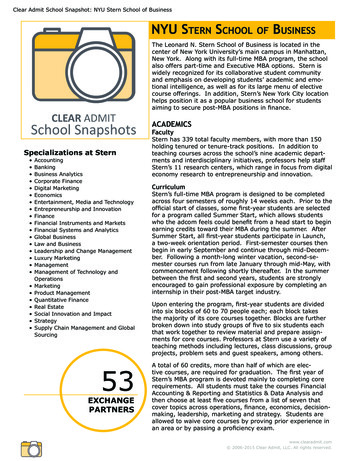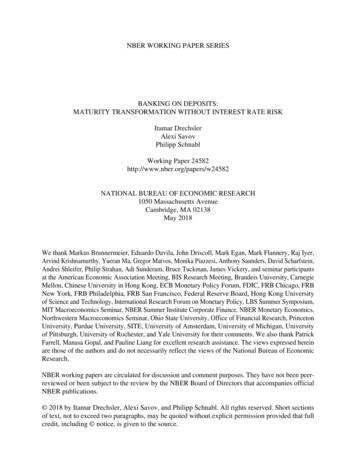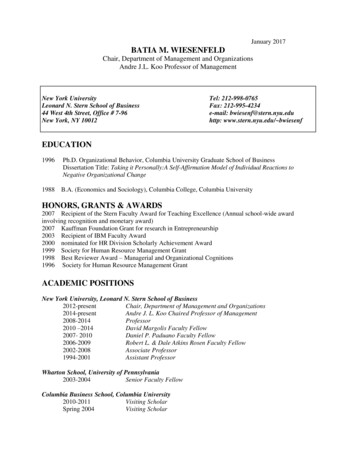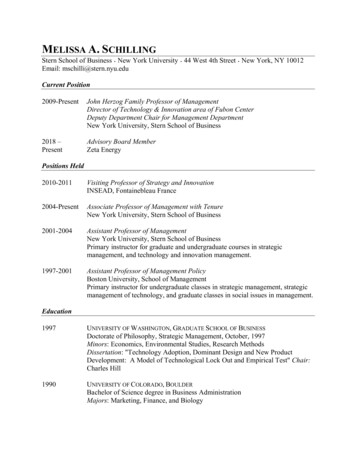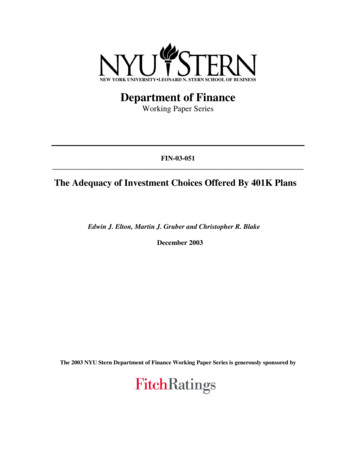
Transcription
NEW YORK UNIVERSITYyLEONARD N. STERN SCHOOL OF BUSINESSDepartment of FinanceWorking Paper SeriesFIN-03-051The Adequacy of Investment Choices Offered By 401K PlansEdwin J. Elton, Martin J. Gruber and Christopher R. BlakeDecember 2003The 2003 NYU Stern Department of Finance Working Paper Series is generously sponsored by
The Adequacy of Investment Choices OfferedBy 401K PlansEdwin J. Elton*Martin J. Gruber*Christopher R. Blake*** Nomora Professors of Finance, New York University** Professor of Finance, Fordham University
The Adequacy of Investment Choices Offered by 401K PlansAbstractDefined-contribution plans represent a major organizational form for investors’retirement savings. Today more than one third of all workers are enrolled in 401K plans. In a401K plan, participants select assets from a set of choices designated by an employer. For overhalf of 401K-plan participants, retirement savings represent their sole financial asset. Yet to datethere has been no study of the adequacy of the choices offered by 401K plans. This paperanalyzes the adequacy and characteristics of the choices offered to 401K-plan participants forover 400 plans. We find that, for 62% of the plans, the types of choices offered are inadequate,and that over a 20-year period this makes a difference in terminal wealth of over 300%. We findthat funds included in the plans are riskier than the general population of funds in the samecategories. We study the characteristics of plans that are associated with adequate investmentchoices, including an analysis of the use of company stock, plan size, and the use of outsideconsultants. When we examine one category of investment choices, S&P 500 index funds, wefind that the index funds chosen by 401K-plan administrators are on average inferior to the S&P500 index funds selected by the aggregate of all investors.Keywords: 401K plans, pension, spanning, portfolio, investment choicesJEL classification: G11, G12, G23, E21
A major trend in pension plans offered by companies is a movement from defined-benefitplans to defined-contribution plans. The majority of defined-contribution plans offered bycompanies are 401K plans. More than one third of all workers are enrolled in 401K plans, andthese plans have over one trillion dollars under management. There has been some research onhow investors react given the investment choices they face. For example, investors tend toallocate their funds equally over the investments they are offered. This is often referred to as the“1/n Rule” (see Benartzi and Thaler (2001) and Liang and Weisbenner (2002)). Another findingis that investors over-invest in stock of the company for which they work (see Huberman andSengmuller (2003) and Agnew and Balduzzi (2002)).With all the interest in how investors react given the choices they are offered, it issurprising that there have been no studies of the appropriateness of the decisions thatcorporations make with respect to which investment choices to offer plan participants. Theinvestment alternatives offered are important to participants because, for over one half of planparticipants, the 401K investments are their sole financial assets. Even for those participants whohold other financial assets, the 401K assets are likely to be the bulk of their financial assets, sothat plan offerings are likely to restrict the portfolios they can hold.What choices should a corporation offer to plan participants? For those participants forwhom 401K investments are their sole financial assets, the corporation should offer a sufficientset of investment alternatives so that the investor could construct the same efficient frontier thathe or she would obtain if there were choices from a reasonable set of alternatives. Investors whohave other financial assets would not be hurt by such a strategy, so this strategy is dominant for
all investors.1 In this paper we examine the adequacy of the investment alternatives offered by401K plans utilizing mutual funds.This paper is divided into eight sections. In the first section we discuss the data used. Inthe second section we discuss two ways of classifying investment choices to form alternativeportfolios to compare against actual 401K plan offerings, and we explore which type ofclassification offers the best set of alternative choices for plan participants. In the third sectionwe examine the minimum number and types of alternative investment choices to include in theoptimal choice set of the comparison portfolios. In the fourth section we examine whether or notthe mutual funds offered would suggest that 401K plan administrators consider risk in decidingwhich investment choices to offer. In the fifth section we explore issues of how well the fundofferings span the efficient set. In that section, we not only examine statistical tests, but we alsoexamine economic significance (effect on participants’ returns) of a failure to provideappropriate offerings. In the sixth section we examine the effect of offering company stock onplan risk and the efficient frontier. In section seven we examine whether other characteristics ofthe plans affect the appropriateness of the investment choices offered to plan participants.Finally, in section eight we summarize our results.I. DataOur data were provided by Moody’s Investor Services. Moody’s collects data by meansof a survey of pension plans offered by both for-profit and non-profit entities (collected in 2002with information through 2001). From this data set we selected all 401K plans that employedpublicly available mutual funds for participant choices. However, we did not exclude plans that1If a plan is administered by an external party, the administrator may charge additional fees if the companywishes to include funds outside the external party’s normal offerings. However, there are so many plan
offered, in addition to mutual funds, non-public money market funds, GICs and stable valuefunds and/or company stock. We were able to identify 680 401K plans for which the CRSPmutual fund database contained at least some data on each of the mutual funds offered in theplan. Of the 680 plans, 417 had at least five years of total returns data in the CRSP database forevery mutual fund they offered.2 For each of these plans we collected data on the mutual fundsoffered, historical returns for each mutual fund, and the names and characteristics of the firmsoffering the plans.Table 1 shows the number of distinct investment choices offered by the 680 plansmentioned above. The median number of 401K plan offerings is eight. Approximately 12% ofthe 401K plans offer four or fewer investment choices, and approximately 11% offer 13 or moreinvestment alternatives. The median number of investment offerings we report is somewhat lessthan that reported by Huberman and Sengmuller (2003). Huberman and Sengmuller’s datasample came from 401K plans managed by Vanguard. Many plans restrict their offerings to onefund family. Vanguard is one of the largest mutual fund families in terms of number of fundsoffered. Thus it is not surprising, and is consistent with what we observed in our sample, thatplans managed by Vanguard offer more choices than would be observed in the population.Table 2 shows the percentage of plans that offer various types (using ICDIclassifications) of investment choices to their participants. The most common investment choice(offered by 97.4% of plans) is a domestic equity fund. The next most common offering (86.8%)is an alternative such as a GIC or money market fund, where interest is intended to be the onlysource of return. Other common offerings fall in the following categories: domestic bond fundsadministrators for a company to choose from that this is unlikely to have an effect on our findings.2When later we draw general samples of mutual funds for comparison purposes, we use the same selectionprocedure so that comparisons are not biased.
(71.5%), domestic mixed bond and stock funds (80.6%), and international bond and/or stockfunds (75.1%). The high percentage of 401K plans that offer international funds is surprising,given the much lower percentage international funds constitute of mutual funds publiclyavailable to investors. Finally, 22.9% of the 401K plans offer company stock as an alternative fortheir participants.Forty-eight of the 680 plans offered pension participants at least one specialized fund asan alternative choice; there were a total of 56 such choices. Thirty-one of these specialized fundswere science and technology funds, six were real estate funds, five were telecommunicationsfunds, four were healthcare funds, four were natural resources funds, four were utilities funds,one was an e-commerce fund and one was a financial services fund. There is no relationshipbetween type of specialized funds offered and the type of firm offering the 401K plan. We notedthat 33 of the 56 specialized funds were T. Rowe Price funds, suggesting that recommendinginclusion of a specialized fund is a strategy employed to market T. Rowe Price funds to 401Kplan administrators. The large number of science and technology funds offered at the date oursample was constructed suggests that some plan administrators were including the then-current“hot” sector.II. Determining the Comparison PortfoliosIn order to determine if 401K plans offer their participants adequate investment choices,we need to hypothesize an adequate set of alternative investment choices. There are twoapproaches we can use to determine an adequate set of alternative investment choices. The firstapproach draws on the field of financial economics, where extensive literature exists thatdiscusses indexes that are necessary and sufficient to capture the relevant return characteristics
for a range of investment choices. The second approach draws on the development by thefinancial industry of a set of classifications that the industry finds relevant for classifyinginvestment portfolios. These classifications represent the investment industry’s attempt toseparate mutual funds into groups that behave similarly and define a complete set of relevantinvestment choices. In this section of the paper we examine both of these methods for classifyinginvestments to see which classification provides a better set of alternative investment choices.Initially, we examine classifications from research on what affects returns. For commonstocks, we classified by value versus growth and by size as advocated by Fama and French(1994). Because of industry practice, we classified by size into three groups: small-cap, mid-capand large-cap. Each of these three groups was then further divided into value and growth.3 Allsix indexes were taken from Wilshire. We chose Wilshire indexes because there are existingtradeable funds that attempt to match them. For bonds, we used a general bond index, includinggovernments and corporates, a mortgage-backed index, and a high-yield index. This division issupported by Blake, Elton and Gruber (1993), who found this division was sufficient to capturedifferences in return across bond funds. We used the Lehman U.S. Government/Credit index forthe general bond index, the Lehman Fixed-Rate Mortgage-Backed Securities index for themortgage index, and the Credit Suisse First Boston High-Yield index for the high-yield bondindex. We also included the Salomon Non-U.S.-Dollar World Government Bond index forinternational bonds and the MSCI EAFE index for international stocks.43This division is also supported by Elton, Gruber and Blake (1999), who found that these indexes plus abond and international index captured most of the return differences among funds.4We also considered adding a real estate index. However, only six of our 417 sample 401K plans include areal estate fund. Therefore, we dropped real estate when we looked at sufficiency of offerings of 401K plans, so thatrejection of sufficiency of any sample 401K plan’s offerings would not be due to the exclusion of a real estateinvestment choice. However, we should note that inclusion of a real estate index did improve the efficient frontier insome periods.
Since returns on all mutual funds are computed after expenses, we deducted expensesfrom each of our indexes. For each of our indexes, we used the expense charge of the index fund(including exchange-traded funds) that most closely matched the index. If there were multipleindex funds matching the index, we used the expense charge of the lowest cost fund. In whatfollows we refer to these indexes as “Research-Based” indexes, or “RB” indexes.The second method for selecting categories of funds that might be appropriate to includein 401K plans is to use one of the public investment services’ fund classifications based on fundobjectives and policies. These classifications represent the investment industry’s attempt todivide funds into groups that behave similarly and are a complete set of investment alternatives.Groups based on ICDI classifications and the percentages of plans that offer any particular groupto a participant are shown in Table 2. For each ICDI investment objective group except interestonly funds and utility funds, we computed a monthly return index starting in January 1992 andending December 2001 (10 years) by taking an equally weighted average each month of thereturns on all funds in the group that existed as of January 1992. If, during the 10-year period, afund ceased to exist or changed objectives, the fund was dropped from the index at that point intime.5 In what follows we will refer to these indexes as “Objective and Policy-Based” indexes, or“OPB” indexes.In the next section, we compute Sharpe ratios and perform intersection tests to examinewhich of these classifications provide better opportunities for investors.5The CRSP mutual fund database is not very accurate in properly recording when a firm ceased to exist orchanged objective. Elton, Gruber and Blake (2001) showed this does not add bias. The way we constructed eachindex assumes investors reallocate their money across the remaining funds in the group when a fund changesobjectives or ceases to exist.
II.A. Sharpe RatiosTable 3 shows the Sharpe ratios for optimal portfolios when short sales are not allowedconstructed from the 11 RB indexes and the 14 OPB indexes for the ten-year period 1992-2001and the two five-year sub-periods.6 In computing Sharpe ratios we used as the risk-free rate theaverage of the 30-day CRSP T-bill rate over the relevant period. In the two five-year sub-periodsand in the 10-year period the Sharpe ratios are higher for the efficient frontier calculated usingreturns on the RB indexes. Furthermore, the differences in Sharpe ratios between the two sets ofindexes are statistically significant in both of the five-year subperiods. (The significance tests aredescribed in Appendix A.)The evidence in Table 3 indicates that classifying funds along the lines suggested by theliterature of financial economics may be superior to accepting commonly used objective andpolicy classifications such as those provided by ICDI. Next we will examine intersection tests tosee what this adds to the analysis.II.B. Intersection TestsOne of the principal tests used in this paper is a test of intersection, a particular form ofspanning. For example, if a set of choices were offered to holders of a 401K plan, do thesechoices lead to the same efficient frontier as would a more general set of options? Spanning isimportant because for over half the 401K participants the 401K investments are their solefinancial investments. Tests of spanning are discussed in Huberman and Kandel (1987), DeSantis (1994), Bekaert and Urias (1996) and DeRoon, Nijman and Werker (2001), among others.In this article we make use of the results derived in DeRoon et al (2001) for the case of shortsales disallowed. At this point we will provide an intuitive explanation for the methodology used
both in this section and in later sections of this paper, followed by an application of themethodology to RB and OPB indexes.II.B.1. MethodologyThe purpose of the intersection test is to examine whether, given a riskless rate, aparticular set of benchmark assets is sufficient to generate the efficient frontier or whetherincluding (long or possibly short) members of a second set of assets would improve the efficientfrontier at a statistically significant level.As DeRoon et al (2001) have shown, if the optimal (tangent) portfolio consists of Kbenchmark assets, then intersection is a test of the impact of restricting the intercept (α) in thefollowing time-series model:K()Rit R f α i β ik RktB R f ε itk 1(1)whereRit the return on non-benchmark asset i (i 1, , N) in month t;R f the risk-free rate;RktB the return on benchmark asset k in month t;ε it the error term for asset i in month t.When short sales are allowed, intersection occurs if, for all of the N non-benchmarkassets jointly, the α i are not statistically significantly different from zero, i.e., the restrictions areαi 0 i6(1a)Throughout this paper, the case of short sales not allowed is emphasized because a plan’s participants cannot short sell the mutual funds offered by the plan.
When short sales are not allowed, the right-hand side of equation (1) includes returns ononly those benchmark assets that are held long in the optimal portfolio of benchmark assets.7Intersection occurs if, for all of the N non-benchmark assets jointly, the α i are not statisticallysignificantly positive, i.e., the restrictions areαi 0 i(1b)The logic behind the test can be easily understood. In the case of short sales allowed if anasset had a positive (or a negative) alpha, then including the asset long (or short) would improvethe efficient frontier. Without short sales, only the inclusion of an asset with a positive alphawould improve the efficient frontier.To test whether, given a riskless rate, we have a set of benchmark assets that spans therelevant space, we simply have to test the unrestricted model (equation (1)) against the modelwith the restrictions on alpha. This involves employing equation (1) using the restrictions (1a)( α i 0 i) for the case where short sales are allowed and using the restrictions (1b) ( α i 0 i) for the case where they are not allowed.To test whether or not the restrictions hold, we use the likelihood ratio test statisticsuggested by Gallant (1987) with small-sample adjustment. The likelihood ratio test is:( L T ln Σ ln Σˆ )(2) where T is the number of time-series observations, Σ is the estimated variance-covariance matrixof the residual errors of the N non-benchmark assets from the restricted equation, and Σ̂ is theestimated variance-covariance matrix of the residual errors of the N non-benchmark assets fromthe unrestricted equation. L is asymptotically distributed as chi-squared with q degrees of7These benchmark assets can be easily identified by solving a quadratic programming problem.
freedom, where q is the number of parametric restrictions. For small samples such as we havecross-sectionally, Gallant recommends the use of the F distribution with degree-of-freedomcorrections instead of the chi-squared distribution. The small-sample adjustment is simply tocompare L to q Fx , where Fx is the F statistic at significance level x with q numerator degreesof freedom and T M – p denominator degrees of freedom, and where M is the number ofequations estimated and p is the number of parameters. If L is greater than q Fx , then the nullhypothesis that the restrictions hold is rejected.II.B.2. ResultsSince Sharpe ratios suggest that RB indexes are potentially superior to OPB indexes, weexamine the following question: if we construct the efficient frontier using RB indexes, doesadding OPB indexes shift the efficient frontier?When we do not allow short sales, the answer is the same in each five-year subperiod andin the overall ten-year period. We can not reject the hypothesis that the intercepts are zero or lessfor the OPB Index, which implies that adding OPB Indexes does not shift the efficient frontier.In fact, in the ten-year period and both five-year subperiods, the determinants of the constrainedand unconstrained variance-covariance matrices of the residuals are the same.When short sales are allowed, adding the OPB Index causes the efficient frontier to shiftand we reject the hypothesis that the intercepts are zero. However, examining the individualintercepts reveals an interesting pattern. In the ten-year period and both five-year subperiods, allintercepts from the unrestricted model are negative in the case where short sales are not allowed.This means that the efficient frontier shifts because we short-sell the OPB indexes. Since shortsales are not allowed for 401K plans, none of the OPB indexes improves the choice set. Theuniversally negative intercepts also explain why the determinants of the constrained and
unconstrained variance-covariance matrices of the residuals are the same. The constraint that theintercepts are non-positive is not binding.The intersection tests show that none of the OPB indexes improve optimal portfoliosderived from RB indexes when short sales are not allowed. In addition, the Sharpe ratio teststend to support the conclusion that RB indexes provide a better set of alternatives. Thus, in whatfollows we will use the categorization suggested by financial research. This set of choices worksat least as well as the set of choices that the investment community accepts as sufficient todelineate the relevant choice set for investors.III. Reducing the Number of ChoicesHaving determined that the categorization from financial research is no worse andprobably better than commonly used objective and policy classifications, the next question to askis whether some of the RB index classifications are redundant and, if so, what is the compositionof the reduced set. We want to exclude redundant indexes from our index set, because theirinclusion might result in our rejection of the adequacy of the investment choices offered by someplans purely on the basis of chance. We examine reducing the set of indexes in three ways:composition of efficient frontiers, factor analysis, and cluster analysis. We present the details ofthe analyses in Appendix B, and we summarize the results below.We first examined composition of the efficient portfolio for each of 12 time periods.Some categories (e.g., mid-cap growth stocks) never entered the efficient frontier, while others(e.g., mid-cap value and small-cap value) occasionally entered and often substituted for eachother.
We next performed maximum-likelihood factor analysis on the data. Using several testsfor statistical significance, a five-factor solution was indicated. Rotating the five factors (usingquartimax rotation) allowed us to associate economic characteristics with each of the five factors.However, two of the factors involved a positive weight on one index and a negative weight on asecond index (e.g., a positive weight on the growth index and a negative weight on the valueindex), and, since pension funds can not short sell securities, replicating the five factors requiresat least seven of our original 11 indexes.As a final step, cluster analysis was performed on the 11 RB indexes. The resultsindicated 8 identifiable groups. From the analysis, three pairs of the 11 RB indexes werecombined (small-cap growth with mid-cap growth, small-cap value with mid-cap value, andgovernment/corporate bond with mortgage bond), leaving us with a final set of 8 RB indexes.IV. Diversification of 401K Plan OfferingsIn this section we examine the extent to which 401K plan administrators consider riskwhen they decide on which investment choices to offer plan participants. To examine this, wecompare the risk of the actual 401K plan offerings to the risk of offerings from “synthetic” 401Kplans constructed by using random selection of publicly available mutual funds. We have severalways to implement this random selection. The simplest, and most direct, method is to make theodds of selecting a fund from any ICDI category equal to the proportion of that category held byour sample of 401K plans. Within a category (e.g., aggressive growth) the odds of choosing anysingle fund are made equal. The population of funds from which we select consists of all fundsthat exist as of the end of 2001 and have five years of history. These are the same criteria weused when selecting 401K plans to include in our total returns sample.
This is an extremely naïve selection rule that ignores completely the correlation betweenICDI categories. A slightly less naïve strategy would force all synthetic plans to hold at least onerandomly selected bond fund and one randomly selected stock fund. Examining the holdings ofthe actual 401K plans shows that this is a strategy followed by many plans. Thus our secondrandom-selection strategy, called “constrained random selection,” follows the same randomselection rules described above except that all synthetic plans are forced to hold at least one bondand one stock fund.To calculate portfolio variances for both the actual 401K plans and the synthetic 401Kplans, we need to formulate a rule to represent the investment weighting for a hypothetical planparticipant. Given the strong evidence that plan participants equally weight their 401K planofferings (see Benartzi and Thaler (2001) and Liang and Weisbenner (2002)), we use onedivided by the number of a plan’s investment choices to represent a participant’s choseninvestment weight in each of the plan’s mutual fund offerings.8While estimates of variances and covariances differ according to the random-selectionrules we use, we can compute overall synthetic plan portfolio variance for each random-selectionrule using the standard formula for an equally weighted portfolio.9 The portfolio variance is: N 1 1 VarPN Var Cov N N (3)where VarPN is the average variance of a portfolio consisting of N funds drawn at random fromour population of mutual funds, with equal investment in each fund selected, and Var and Covare the average fund variance and the average covariance between funds, respectively, if funds8funds.We exclude from the investment choice sets company stock, GICs, stable value funds and money market
are selected using either of the random selection techniques discussed earlier. (For details onhow Var and Cov are calculated, see Appendix C.)Table 4 presents the average values (by number of funds offered) of the variances for theactual 401K plans as well as the variances that would occur if plan sponsors selected funds atrandom using either of the selection rules described above.10 The first thing to note from Table 4is that, while on average the variance of return on actual 401K plans is lower than the variancewould have been if plan sponsors had randomly selected a set of mutual funds, it is higher oncewe make the realistic assumption that the synthetic plans have at least one bond fund and onestock fund. Plans on average have a variance that is 2.29 lower than that using random selectionof funds but 2.087 higher than that using constrained random selection.11 Both differences arestatistically significant at better than the 0.01 level. It is also interesting to note that as plans offermore investment choices (beyond three) the overall risk is reasonably flatTo gain more insight into the risk of 401K plans, we separately examined the averagevariance of individual funds held by all plans and the average correlations between the fundsheld by all 401K plans. The average individual variance of the mutual funds held by 401K is26.76. If 401K plan sponsors selected mutual funds randomly but maintained the samepercentage in each ICDI category as the aggregate of all plans, the average fund variance wouldhave been 30.49. If instead we simply computed an average fund variance across all mutualfunds, weighting each fund equally, the variance would be 31.26. Thus 401K plan administrators9See Elton and Gruber (1977).10Only one of our 417 sample 401K plans offered 17 funds; therefore we do not report average values for 17fund plans in Table 4.11Because average variances can not be constructed using constrained random selection for plans with only 1fund, the reported averages and significance tests exclude the 10 401K plans in our sample that offered only 1 fund(along with the one plan that offered 17 funds) for a total of 406 funds.
select mutual funds with a lower fund variance both relative to what it would be if they randomlyselected funds while maintaining the aggregate plan proportions in ICDI categories and relativeto what it would be if they simply randomly selected across all available funds.The other element that affects portfolio variance is correlation. The average pairwisecorrelation among funds selected by 401K plans is 0.60, while for random selection, maintainingICDI proportions, it is 0.55. The difference is statistically different at the 1% level. Thus planadministrators select funds that are more highly correlated than the average correlation betweenpairs of funds.Overall, plan administrators offer plan participants mutual funds with less variance thanrandomly selected funds, but funds that are more highly correlated. Managers appear to pay moreattention to a fund’s variance than to the correlation of the fund with other plan choices whenselecting funds. For plan participants using the 1/n Rule, this results in lower variance than purerandom selection. However, it results in a much higher variance than random selection if allrandom portfolios are constrained to include at least one bond and one stock fund.12V. Adequacy of Plan OfferingsIn looking at the adequacy of plan offerings, we have to look beyond the risk attributesdiscussed above, since return as well as risk affects the efficient frontier. In this section we usespanning test
NEW YORK UNIVERSITYyLEONARD N. STERN SCHOOL OF BUSINESS Department of Finance Working Paper Series FIN-03-051 _ The Adequacy of Investment Choices Offered By 401K Plans Edwin J. Elton, Martin J. Gruber and Christopher R. Blake December 2003 The 2003 NYU Stern Department of Finance Working Paper Series is generously sponsored by .
